Effect of Zr Additions on the Microstructure and Elevated-Temperature Mechanical Properties of Al–Cu–Mg–Ag–Zn–Mn–Zr Alloys
Abstract
1. Introduction
2. Materials and Methods
3. Results and Discussion
4. Conclusions
- (i)
- The Al–4.0Cu–0.5Mg–0.5Zn–0.5Mn–0.4Ag–0.16Zr alloy demonstrates superior mechanical properties at both room and elevated temperatures compared to other compositions, achieving a peak tensile strength of 368.8 MPa and retaining the highest tensile strength retention ratio of 0.798 at 200 °C.
- (ii)
- The introduction of Zr facilitates the precipitation of Al3Zr phase, effectively pinning grain boundaries and dislocations to enhance recrystallization resistance while preserving deformed microstructures. However, excessive Zr content induces non-uniform grain size distribution and significant Schmid factor variations among grains. This heterogeneity promotes stress concentration near coarse deformed grains with high Schmid factors, triggering dislocation accumulation that initiates premature intergranular cracking and ultimately degrades alloy performance.
- (iii)
- Al3Zr particles serve as heterogeneous nucleation sites for Ω-phase precipitation. When dispersively distributed near grain boundaries, they accelerate Ω-phase nucleation at these interfaces, refine grain boundary precipitates, and narrow precipitate-free zone (PFZ) widths. These coordinated microstructural modifications collectively enhance the alloy’s mechanical properties.
Author Contributions
Funding
Institutional Review Board Statement
Informed Consent Statement
Data Availability Statement
Conflicts of Interest
Abbreviations
| PFZs | Precipitate-free zones |
| OM | Optical microscopy |
| SEM | Scanning electron microscopy |
| EBSD | Electron backscatter diffraction |
| TSL | Tex Sem Lab |
| IPF | Inverse pole figure |
| TEM | Transmission electron microscopy |
| BSE | Backscattered electron |
| HABs | High-Angle Boundaries |
| LABs | Low-Angle Boundaries |
| FFT | Fast Fourier Transform |
References
- Polmear, I.J.; Pons, G.; Barbaux, Y.; Octor, H.; Sanchez, C.; Morton, A.J.; Borbidge, W.E.; Rogers, S. After Concorde: Evaluation of Creep Resistant Al–Cu–Mg–Ag Alloys. Mater. Sci. Technol. 1999, 15, 861–868. [Google Scholar] [CrossRef]
- Heinz, A.; Haszler, A.; Keidel, C.; Moldenhauer, S.; Benedictus, R.; Miller, W.S. Recent Development in Aluminium Alloys for Aerospace Applications. Mat. Sci. Eng. A 2000, 280, 102–107. [Google Scholar] [CrossRef]
- Huda, Z.; Zaharinie, T.; Min, G.J. Temperature Effects on Material Behavior of Aerospace Aluminum Alloys for Subsonic and Supersonic Aircraft. J. Aerosp. Eng. 2010, 23, 124–128. [Google Scholar] [CrossRef]
- Kang, S.J.; Kim, Y.-W.; Kim, M.; Zuo, J.-M. Determination of Interfacial Atomic Structure, Misfits and Energetics of Ω Phase in Al–Cu–Mg–Ag Alloy. Acta Mater. 2014, 81, 501–511. [Google Scholar] [CrossRef]
- Peng, F.; Wang, J.; Yang, R.; Xia, Y.; Zhang, G.; Cai, B. Creep Behavior and Microstructural Evolution of Al–Cu–Mg–Ag Alloys with Various High Cu Contents. Metals 2021, 11, 487. [Google Scholar] [CrossRef]
- Chen, J.; Ling, K.; Deng, P.; Mo, W.; Tang, C.; Ouyang, Z.; Luo, B.; Bai, Z. Effect of Mg Content on Microstructure, Mechanical Properties and Intergranular Corrosion Properties of Al–Cu–Mg–Ag Alloys. Mater. Today Commun. 2023, 34, 105363. [Google Scholar] [CrossRef]
- Zhou, X.; Liu, Z.; Bai, S.; Liu, M.; Ying, P. The Influence of Various Ag Additions on the Nucleation and Thermal Stability of Ω Phase in Al–Cu–Mg Alloys. Mat. Sci. Eng. A 2013, 564, 186–191. [Google Scholar] [CrossRef]
- Bai, S.; Zhou, X.; Liu, Z.; Xia, P.; Liu, M.; Zeng, S. Effects of Ag Variations on the Microstructures and Mechanical Properties of Al–Cu–Mg Alloys at Elevated Temperatures. Mat. Sci. Eng. A 2014, 611, 69–76. [Google Scholar] [CrossRef]
- Liu, X.Y.; Wang, Z.P.; Fu, B.G.; Long, L.; Zhang, X.L.; Cui, H.X. Effects of Mg Content on the Mechanical Properties and Corrosion Resistance of Al–Cu–Mg–Ag Alloy. J. Alloys Compd. 2016, 685, 209–215. [Google Scholar] [CrossRef]
- Qi, H.; Liu, X.Y.; Liang, S.X.; Zhang, X.L.; Cui, H.X.; Zheng, L.Y.; Gao, F.; Chen, Q.H. Mechanical Properties and Corrosion Resistance of Al–Cu–Mg–Ag Heat–Resistant Alloy Modified by Interrupted Aging. J. Alloys Compd. 2016, 657, 318–324. [Google Scholar] [CrossRef]
- Kurmanaeva, L.; Topping, T.D.; Wen, H.; Sugahara, H.; Yang, H.; Zhang, D.; Schoenung, J.M.; Lavernia, E.J. Strengthening Mechanisms and Deformation Behavior of Cryomilled Al–Cu–Mg–Ag Alloy. J. Alloys Compd. 2015, 632, 591–603. [Google Scholar] [CrossRef]
- Xu, X.; Liu, Z.; Zhang, B.; Chen, H.; Zhang, J.; Wang, T.; Zhang, K.; Zhang, J.; Huang, P. Effect of Mn Content on Microstructure and Properties of 6000 Series Aluminum Alloy. Appl. Phys. A 2019, 125, 490. [Google Scholar] [CrossRef]
- Zheng, J.; Hu, W.; Kong, J.; Du, X. Effect of Zinc Addition on the Microstructure and Properties of Al–Si–Cu–Mg Cast Alloy. Trans. Indian Inst. Met. 2024, 77, 3267–3277. [Google Scholar] [CrossRef]
- Hlavacs, A.; Petho, D.; Angel, D.; Nagy, E.; Mertinger, V.; Benke, M. The Effect of Mn Content on the Texture of Aluminium Alloys in Cold Rolled and Annealed State. IOP Conf. Ser. Mater. Sci. Eng. 2018, 426, 012017. [Google Scholar] [CrossRef]
- Samuel, A.M.; Samuel, F.H.; Abdelaziz, M.H.; Doty, H.W. Hardening of Al–Si–Cu–Mg Cast Alloys: Role of Ag and Zn Addition. Int. J. Metalcast. 2022, 16, 3–19. [Google Scholar] [CrossRef]
- Qian, D.; Cheng, T.; Gao, W.; Yang, Y. Microstructure Evolution and Mechanical Properties of Low-Silicon Cast Aluminium Alloys with Varying Mn Contents. Philos. Mag. 2021, 101, 1511–1525. [Google Scholar] [CrossRef]
- Wu, M.; Xiao, D.; Wang, X.; Huang, L.; Liu, W. Microstructure, Mechanical Properties and Corrosion Behaviors of Al–Li–Cu–Mg–Ag–Zn Alloys. Materials 2022, 15, 443. [Google Scholar] [CrossRef]
- Shan, Z.; Liu, S.; Ye, L.; Liu, X.; Dong, Y.; Li, Y.; Tang, J.; Deng, Y.; Zhang, X. Effect of Three-Stage Homogenization on Recrystallization and Fatigue Crack Growth of 7020 Aluminum Alloy. J. Mater. Res. Technol. 2020, 9, 13216–13229. [Google Scholar] [CrossRef]
- Li, Q.; Li, J.; Ma, G.; Liu, X.; Pan, D. Influence of ω Phase Precipitation on Mechanical Performance and Corrosion Resistance of Ti–Nb–Zr Alloy. Mater. Design 2016, 111, 421–428. [Google Scholar] [CrossRef]
- Mukhopadhyay, A.K.; Eggeler, G.; Skrotzki, B. Nucleation of ω Phase in an Al–Cu–Mg–Mn–Ag Alloy Aged at Temperatures below 200 °C. Scr. Mater. 2001, 44, 545–551. [Google Scholar] [CrossRef]
- Nassirirad, A.; Emamy, M.; Pourbahari, B. The Effects of Zr and Ti on the Microstructure and Tensile Properties of Al–Cu–Mg Aluminium Alloy. Can. Metall. Q. 2018, 57, 470–480. [Google Scholar] [CrossRef]
- Wang, L.M.; Flower, H.M.; Lindley, T.C. Precipitation of the ω Phase in 2024 and 2124 Aluminium Alloys. Scr. Mater. 1999, 41, 391–396. [Google Scholar] [CrossRef]
- Wang, K.; Yin, D.; Zhao, Y.-C.; Atrens, A.; Zhao, M.-C. Microstructural Evolution upon Heat Treatments and Its Effect on Corrosion in Al–Zn–Mg Alloys Containing Sc and Zr. J. Mater. Res. Technol. 2020, 9, 5077–5089. [Google Scholar] [CrossRef]
- Hu, H.; Zhao, M.; Wu, X.; Jia, Z.; Wang, R.; Li, W.; Liu, Q. The Structural Stability, Mechanical Properties and Stacking Fault Energy of Al3Zr Precipitates in Al–Cu–Zr Alloys: HRTEM Observations and First-Principles Calculations. J. Alloys Compd. 2016, 681, 96–1088. [Google Scholar] [CrossRef]
- Xun, C.; Li, X.; Wen, K.; Geng, L.; Chen, P.; You, W.; Li, Y.; Li, Z.; Zhang, Y.; Xiong, B. Precipitation of Al3Zr Dispersoids under Various Homogenization and Its Effect on Recrystallization in 2198 Al–Cu–Li Alloy. Adv. Eng. Mater. 2023, 25, 2300673. [Google Scholar] [CrossRef]
- Tian, S.; Li, J.; Zhang, J.; Wulabieke, Z.; Lv, D. Effect of Zr and Sc on Microstructure and Properties of 7136 Aluminum Alloy. J. Mater. Res. Technol. 2019, 8, 4130–4140. [Google Scholar] [CrossRef]
- GBT 228.1-2010; Metallic Materials—Tensile Testing Part 1: Method of Test at Room Temperature. Central Iron & Steel Research Institute: Beijing, China, 2010.
- Liu, Q.; Fan, G.; Tan, Z.; Li, Z.; Zhang, D.; Wang, J.; Zhang, H. Precipitation of Al3Zr by Two-Step Homogenization and Its Effect on the Recrystallization and Mechanical Property in 2195 Al–Cu–Li Alloys. Mat. Sci. Eng. A 2021, 821, 141637. [Google Scholar] [CrossRef]
- Dai, K.; Ye, J.; Wang, Z.; Gao, M.; Chen, J.; Guan, R. Effects of Sc and Zr Addition on the Solidification and Mechanical Properties of Al–Fe Alloys. J. Mater. Res. Technol. 2022, 18, 112–121. [Google Scholar] [CrossRef]
- Wang, J.; Yi, D.; Su, X.; Yin, F. Influence of Deformation Ageing Treatment on Microstructure and Properties of Aluminum Alloy 2618. Mater. Charact. 2008, 59, 965–968. [Google Scholar] [CrossRef]
- Yang, Y.; Tan, P.; Sui, Y.; Jiang, Y.; Zhou, R. Influence of Zr Content on Microstructure and Mechanical Properties of As-Cast Al–Zn–Mg–Cu Alloy. J. Alloys Compd. 2021, 867, 158920. [Google Scholar] [CrossRef]
- Boettinger, W.J.; Wheeler, A.A.; Murray, B.T.; McFadden, G.B. Prediction of Solute Trapping at High Solidification Rates Using a Diffuse Interface Phase-Field Theory of Alloy Solidification. Mat. Sci. Eng. A 1994, 178, 217–223. [Google Scholar] [CrossRef]
- Chua, C.; An, J.; Chua, C.K.; Kuo, C.-N.; Sing, S.L. Microstructure Control for Inoculated High-Strength Aluminum Alloys Fabricated by Additive Manufacturing: A State-of-the-Art Review. Prog. Mater Sci. 2025, 154, 101502. [Google Scholar] [CrossRef]

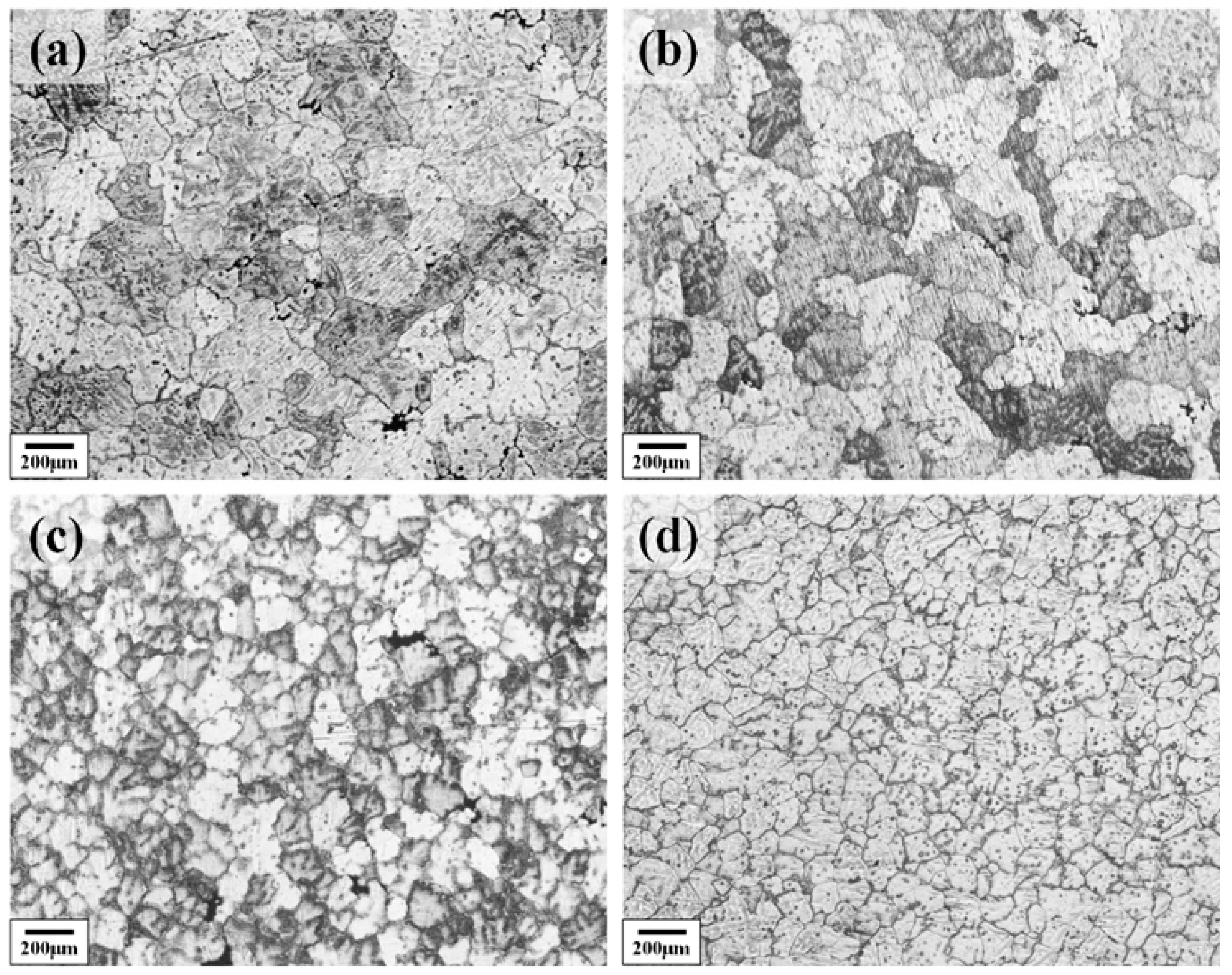
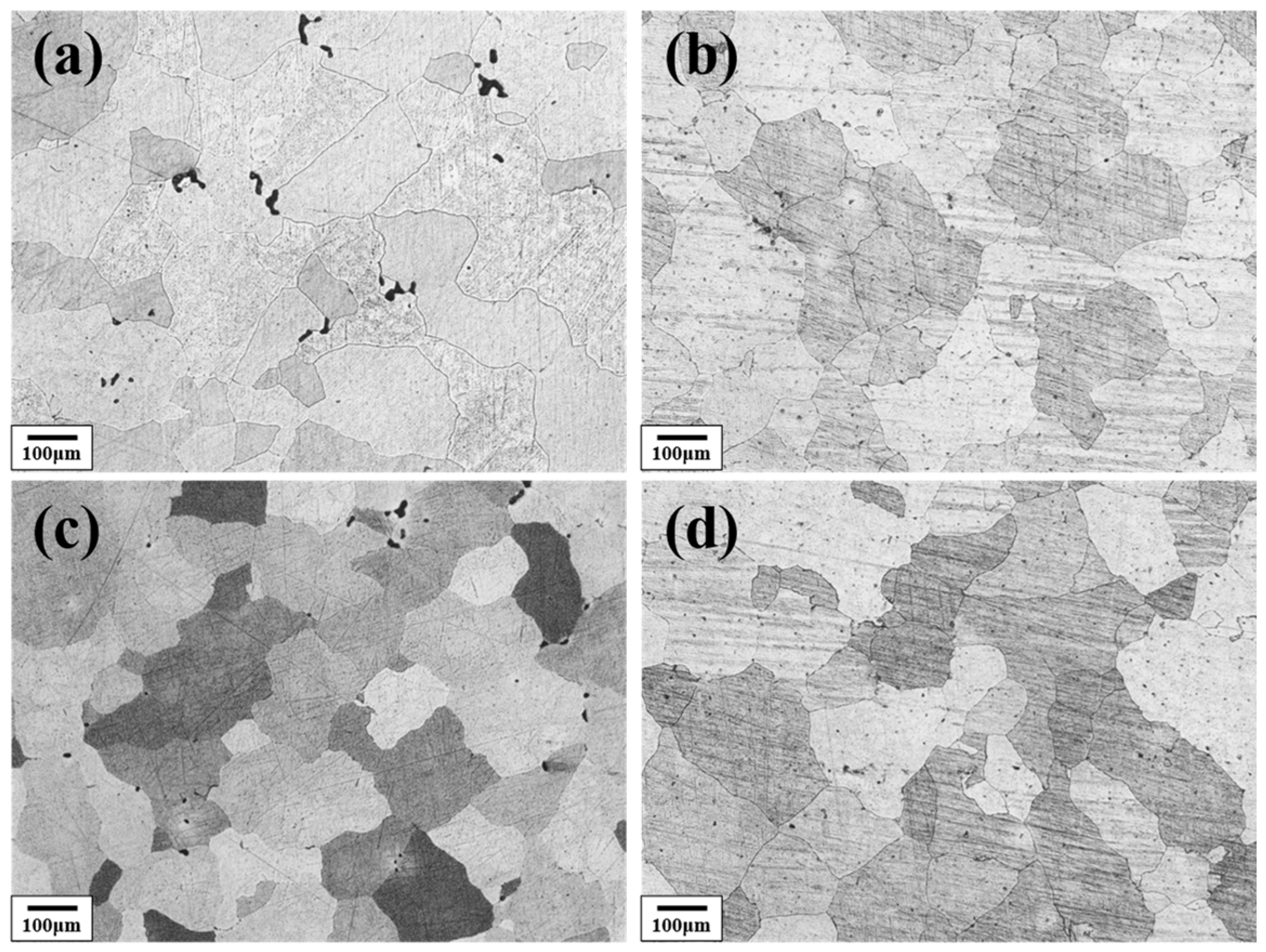
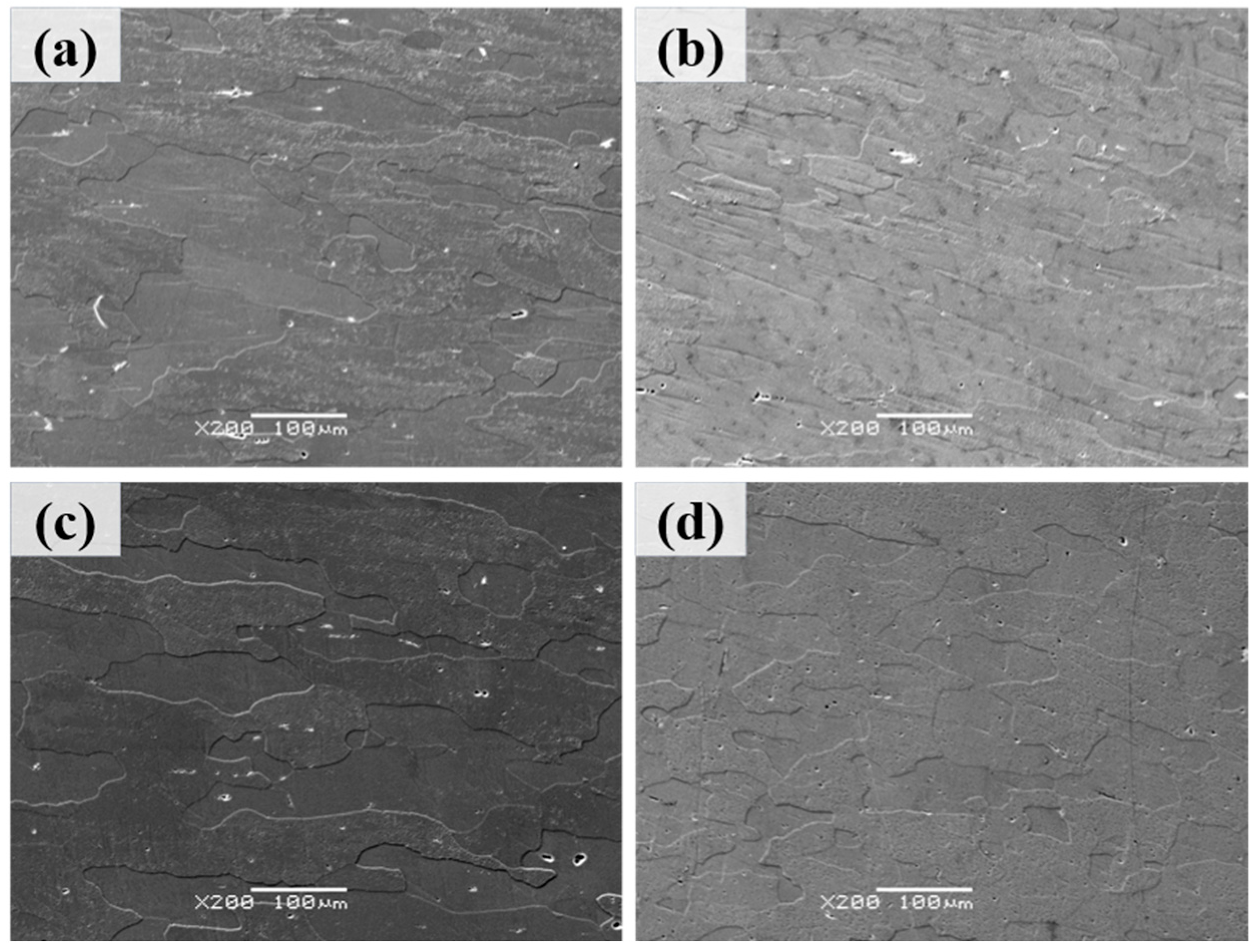
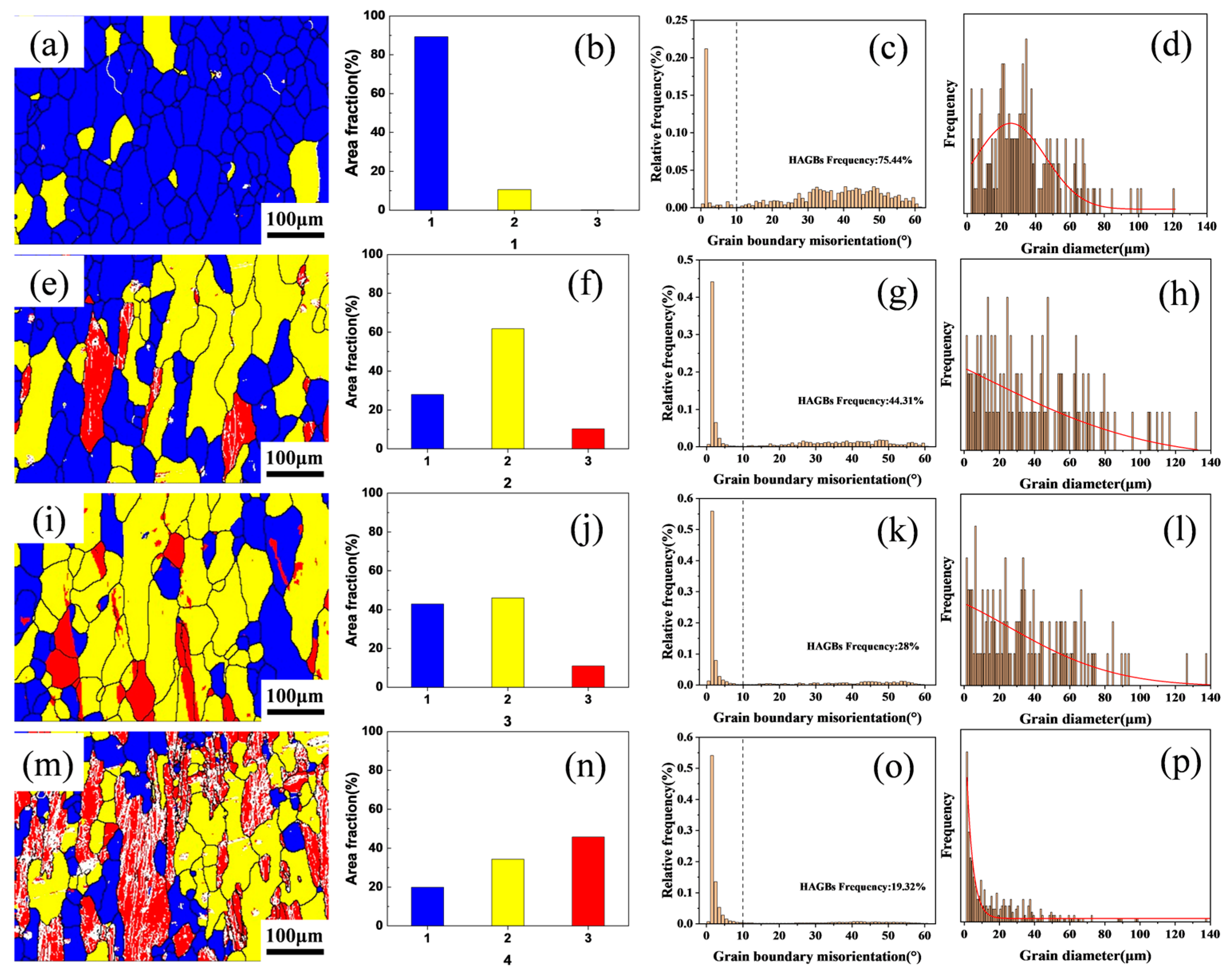
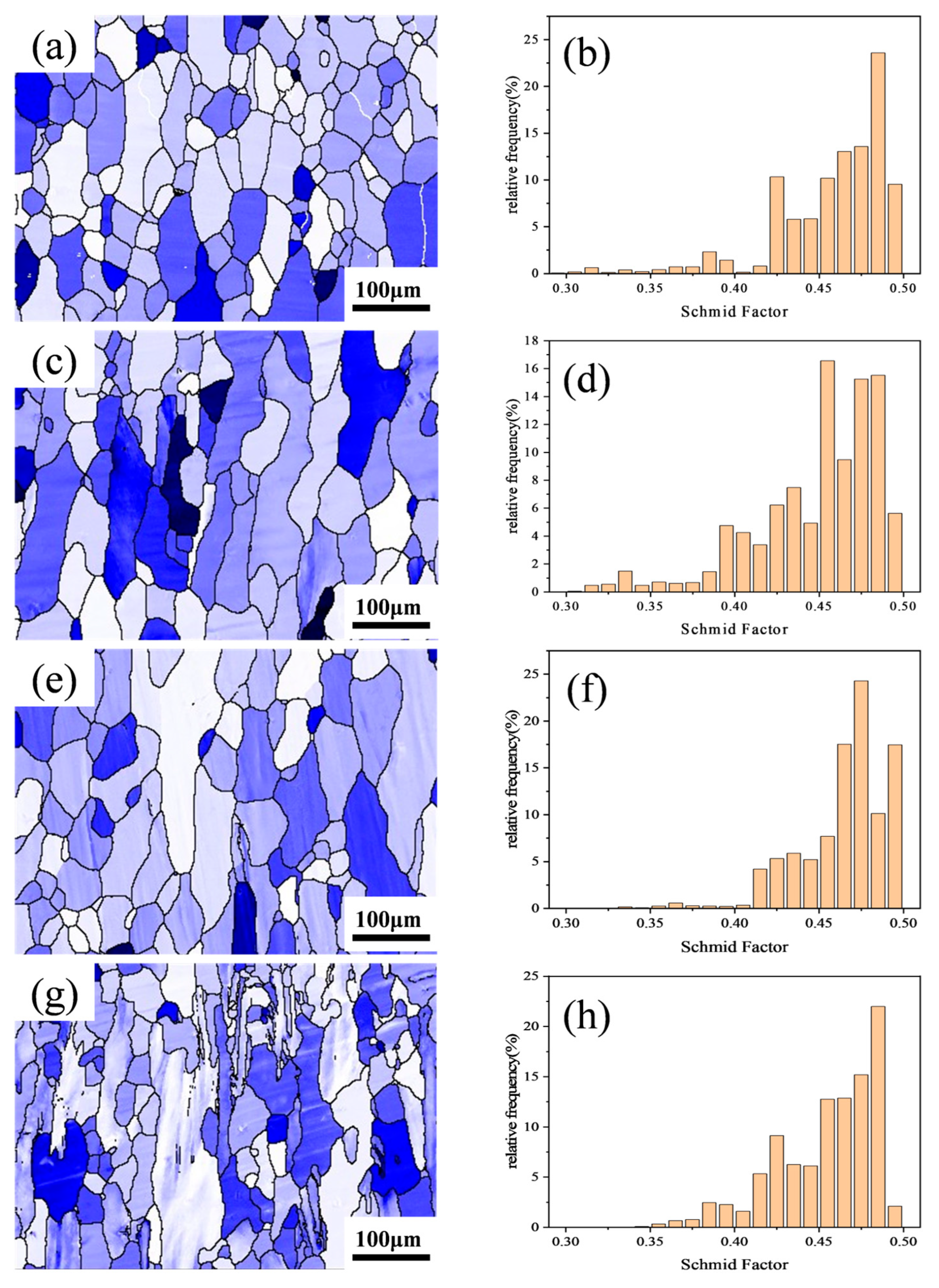



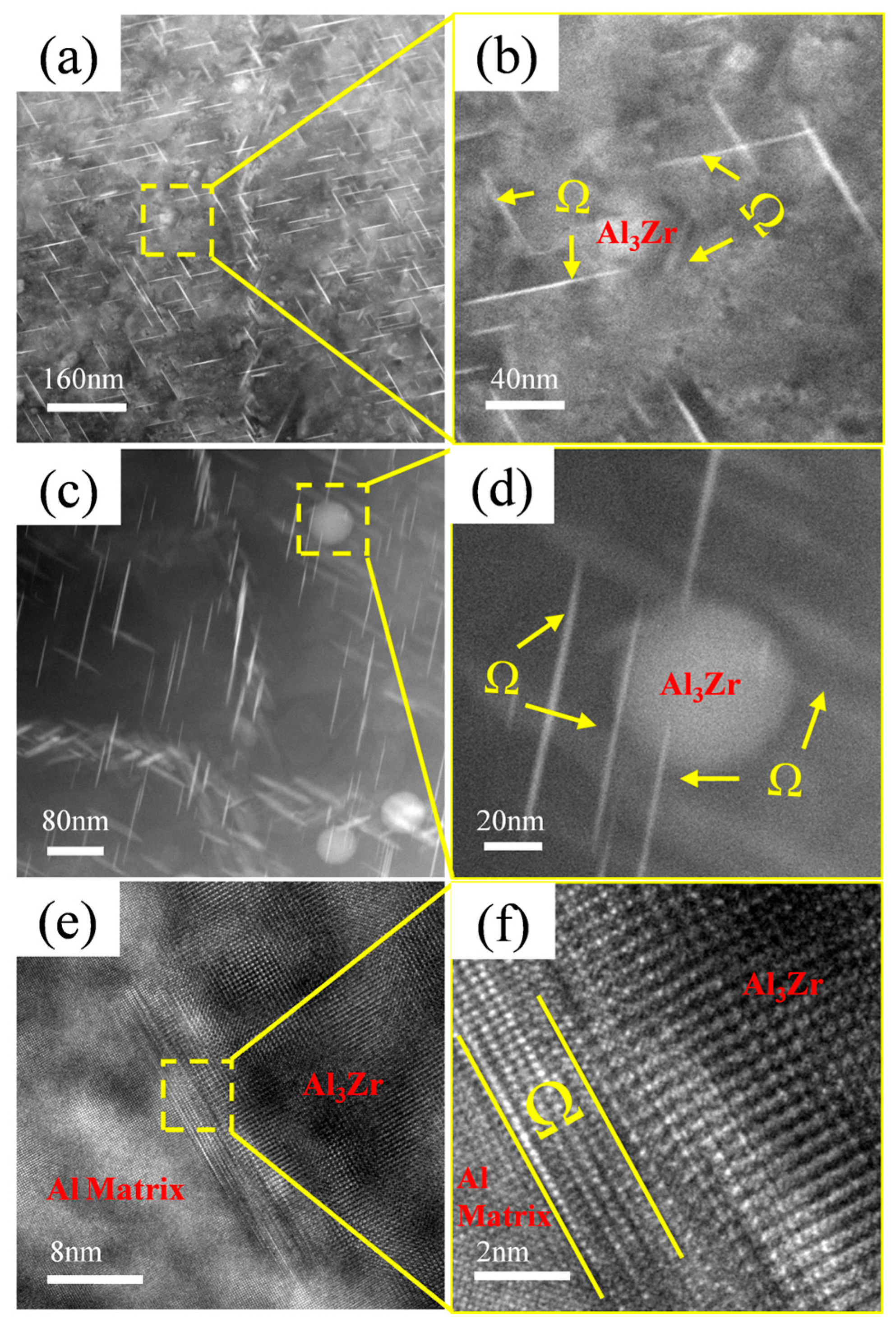
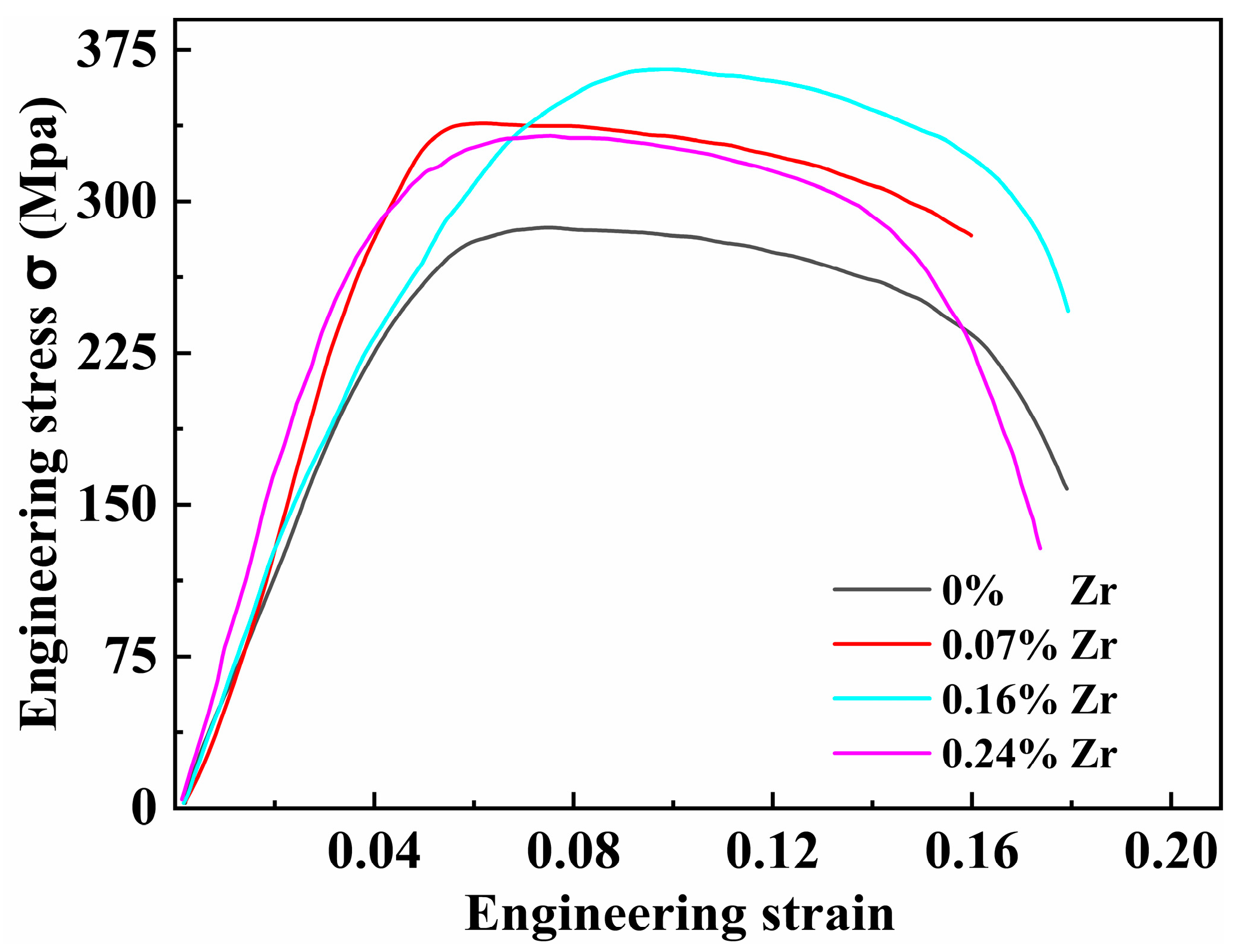
| Cu | Mg | Ag | Zn | Mn | Zr | Al | |
|---|---|---|---|---|---|---|---|
| Alloy 1 | 4.06 | 0.47 | 0.41 | 0.44 | 0.5 | 0 | Balance |
| Alloy 2 | 4.24 | 0.41 | 0.39 | 0.49 | 0.49 | 0.07 | |
| Alloy 3 | 4.31 | 0.5 | 0.34 | 0.42 | 0.53 | 0.15 | |
| Alloy 4 | 4.03 | 0.46 | 0.42 | 0.51 | 0.52 | 0.24 |
| Alloys | Hardness (HV) | Tensile Strength (MPa) | Yield Strength (MPa) | Elongation (%) |
|---|---|---|---|---|
| Al–4.0Cu–0.5Mg–0.5Zn–0.5Mn–0.4Ag | 141.81 | 439.8 | 356.9 | 16.1 |
| Al–4.0Cu–0.5Mg–0.5Zn–0.5Mn–0.4Ag –0.08Zr | 145.67 | 448.7 | 377.4 | 15.1 |
| Al–4.0Cu–0.5Mg–0.5Zn–0.5Mn–0.4Ag–0.16Zr | 152.24 | 461.9 | 390.4 | 15.2 |
| Al–4.0Cu–0.5Mg–0.5Zn–0.5Mn–0.4Ag–0.24Zr | 151.4 | 453.6 | 375.2 | 14.9 |
| 2618A | 441 | 372 | 10 |
| Alloys | Tensile Strength (MPa) | Tensile Strength (MPa) | Elongation (%) | Strength Retention (%) |
|---|---|---|---|---|
| Al–4.0Cu–0.5Mg–0.5Zn–0.5Mn–0.4Ag | 285.87 | 279.42 | 19.5 | 0.650 |
| Al–4.0Cu–0.5Mg–0.5Zn–0.5Mn–0.4Ag–0.08Zr | 337.68 | 333.37 | 17.4 | 0.753 |
| Al–4.0Cu–0.5Mg–0.5Zn–0.5Mn–0.4Ag–0.16Zr | 368.8 | 346.71 | 18.1 | 0.798 |
| Al–4.0Cu–0.5Mg–0.5Zn–0.5Mn–0.4Ag–0.24Zr | 340.4 | 337.38 | 16.9 | 0.750 |
| 2618A | 230 | 203 | 22.4 | 0.562 |
Disclaimer/Publisher’s Note: The statements, opinions and data contained in all publications are solely those of the individual author(s) and contributor(s) and not of MDPI and/or the editor(s). MDPI and/or the editor(s) disclaim responsibility for any injury to people or property resulting from any ideas, methods, instructions or products referred to in the content. |
© 2025 by the authors. Licensee MDPI, Basel, Switzerland. This article is an open access article distributed under the terms and conditions of the Creative Commons Attribution (CC BY) license (https://creativecommons.org/licenses/by/4.0/).
Share and Cite
Fu, H.; Yan, H.; Wei, B.; Sun, B.; Liu, Z.; Gao, W. Effect of Zr Additions on the Microstructure and Elevated-Temperature Mechanical Properties of Al–Cu–Mg–Ag–Zn–Mn–Zr Alloys. Materials 2025, 18, 4062. https://doi.org/10.3390/ma18174062
Fu H, Yan H, Wei B, Sun B, Liu Z, Gao W. Effect of Zr Additions on the Microstructure and Elevated-Temperature Mechanical Properties of Al–Cu–Mg–Ag–Zn–Mn–Zr Alloys. Materials. 2025; 18(17):4062. https://doi.org/10.3390/ma18174062
Chicago/Turabian StyleFu, Haoyang, Hongda Yan, Bin Wei, Bin Sun, Zihang Liu, and Weihong Gao. 2025. "Effect of Zr Additions on the Microstructure and Elevated-Temperature Mechanical Properties of Al–Cu–Mg–Ag–Zn–Mn–Zr Alloys" Materials 18, no. 17: 4062. https://doi.org/10.3390/ma18174062
APA StyleFu, H., Yan, H., Wei, B., Sun, B., Liu, Z., & Gao, W. (2025). Effect of Zr Additions on the Microstructure and Elevated-Temperature Mechanical Properties of Al–Cu–Mg–Ag–Zn–Mn–Zr Alloys. Materials, 18(17), 4062. https://doi.org/10.3390/ma18174062







